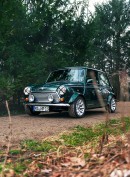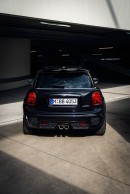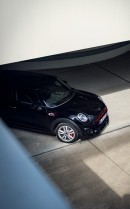Tiny cars aren’t exactly a new concept. In fact, you’ll be hard-pressed to find a tiny automobile in this day and age outside of Japan where the kei car still is king. However, one can’t deny the influence the Cinquecento had on this subgenre.
Launched into production in 1957, the inexpensive and surprisingly practical 500 features a rear-engine, rear-wheel-drive layout. Two years later, the British Motor Corporation revolutionized the segment with the Mini Classic. Penned by Alec Issigonis, the two-door sedan rolled off the line in with a front-engine, front-wheel-drive layout and a transverse engine that shared the oil sump with the gearbox.
3,054 millimeters (120.2 inches) long and 1,410 millimeters (55.5 inches) wide, the oldtimer is seriously small by today’s standards. Munich-based photographer Sven Meschner had the opportunity to shoot the old guard and the newcomer side by side, and as you can tell, the two are like peas in a pod and like apples and oranges at the same time. The styling carries over, alright, but just look at their footprints!
The three-door JCW hatchback is 3,874 millimeters long (152.5 inches) and 1,932 millimeters (76 inches) wide including the mirrors, and don’t even get me started about how much the F56 generation weighs. The all-electric model, for example, tips the scales at 1,365 kilograms (3,009 pounds) compared to 640 kilograms (1,411 pounds) for the Austin Seven 850 Mini from 1959 with the four-speed manual.
However, the Mini – or should I say MINI – isn’t alone. Getting fatter is a trend that’s also obvious in the case of the Fiat 500 mentioned beforehand, the Porsche 911 sports car, and even the Corvette. In the latter’s case, the C8 Stingray weighs nearly 200 pounds (90.7 kilograms) more than the seventh gen in Stingray spec.
Produced from 1959 to October 4th of 2000, the Mini Classic numbers 5,387,862 examples of the breed. Even though the first years under BMW were alright for the British automaker, MINI sales are slipping further and further with each passing year. From 372,194 worldwide sales in 2017 across all model lines, the brand reported 364,135 in 2018 and 347,474 last year.
3,054 millimeters (120.2 inches) long and 1,410 millimeters (55.5 inches) wide, the oldtimer is seriously small by today’s standards. Munich-based photographer Sven Meschner had the opportunity to shoot the old guard and the newcomer side by side, and as you can tell, the two are like peas in a pod and like apples and oranges at the same time. The styling carries over, alright, but just look at their footprints!
The three-door JCW hatchback is 3,874 millimeters long (152.5 inches) and 1,932 millimeters (76 inches) wide including the mirrors, and don’t even get me started about how much the F56 generation weighs. The all-electric model, for example, tips the scales at 1,365 kilograms (3,009 pounds) compared to 640 kilograms (1,411 pounds) for the Austin Seven 850 Mini from 1959 with the four-speed manual.
However, the Mini – or should I say MINI – isn’t alone. Getting fatter is a trend that’s also obvious in the case of the Fiat 500 mentioned beforehand, the Porsche 911 sports car, and even the Corvette. In the latter’s case, the C8 Stingray weighs nearly 200 pounds (90.7 kilograms) more than the seventh gen in Stingray spec.
Produced from 1959 to October 4th of 2000, the Mini Classic numbers 5,387,862 examples of the breed. Even though the first years under BMW were alright for the British automaker, MINI sales are slipping further and further with each passing year. From 372,194 worldwide sales in 2017 across all model lines, the brand reported 364,135 in 2018 and 347,474 last year.





















